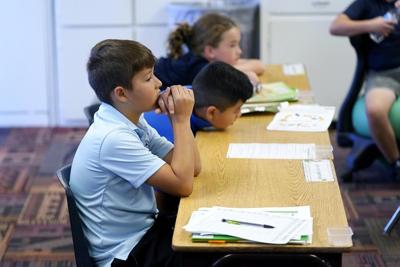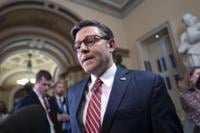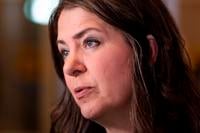MILWAUKEE (AP) — On break in the hallway between St. Marcus Lutheran Church and its attached school, eighth grader Annii Kinepoway had no hesitation in explaining what she’s learned to love best here — the good Lord and good grades.
“I like knowing there’s somebody you can ask for help if you need it. Somebody is there and looking over you,” she said of her newly found faith, while proudly wearing the tie indicating her academic honors.
Annii’s mother could only afford this educational opportunity because of school choice programs, which 94% of St. Marcus’ 1,160 students in Milwaukee also use.
“It has changed our lives for the better,” said Wishkub Kinepoway, a Native American and African American single mom. “She says, ‘I really love St. Marcus because I don’t have to pretend I’m not smart.’”
School choice is one of many , bringing parents to the polls this fall. One core question is how widely, if at all, , instead of only financing public schools. Critics say such programs weaken public schools, whose even if students transfer, taking some state funding with them.
. Public schools often were closed longer than private ones, and extended online learning has been .
But many low-income parents in neighborhoods like Milwaukee’s predominantly African American north side or Latino south side say voucher programs — — are the only way their children can attend faith-based institutions. They say those schools teach structure and values in ways public ones are often too overwhelmed to do.
“It’s a huge difference because it’s a support in faith and in values,” said Lorena Ramirez, whose four children attend St. Anthony, walking distance from home on Milwaukee's south side. “I was looking for a school that would help me.”
St. Anthony is one of the country’s largest Catholic schools – 1,500 students on five campuses who are 99% Latino and almost entirely covered by public funding, said its president, Rosana Mateo. It was founded by German immigrants 150 years ago, just like St. Marcus.
Until the 1960s, urban parochial schools could count on financing from flourishing parishes and cheap payroll costs, since nuns often taught for free. Without those supports, schools started charging substantial tuition, now up to $8,000-$9,000 per academic year — unaffordable for most working-class families.
“Our neediest students should have the opportunity to go to private schools,” said Mateo, a former deputy superintendent in Milwaukee’s public schools.
The expansion and politicization of voucher programs, however, is “no longer targeting really poor kids” but rather “disproportionately helping middle-class, white students,” said Gary Orfield, an education professor and co-director of the Civil Rights Project at the University of California, Los Angeles. His research found students of color have lower test scores and graduation rates when attending low-quality private schools, because most vouchers programs don’t allow for transportation to higher-performing ones.
While urban, faith-based schools don’t necessarily outperform all public ones on test scores, their students enjoy better civic outcomes, from college graduation rates to lower drug use, said Patrick Wolf, a professor of education at the University of Arkansas.
“They contribute more to the community than just educating the kids,” Wolf said.
In Omaha, Nebraska — a state Wolf called a — three Catholic schools in danger of closing formed a foundation.
They’ve raised millions of dollars to serve nearly 600 children, 93% of them students of color and all in need of financial assistance, said the Rev. Dave Korth, foundation president and pastor at one of the related parishes.
Reliable public funds would keep the schools sustainable for parents who choose them “not because of political hot-button things. They simply want their kids in faith-based environments because they believe they’ll be better citizens,” Korth said.
Arizona is at the other end of the school choice spectrum — against strong opposition, allowing every parent to use public funds for private tuition or other education costs.
One such parent is Jill Voss, who’s using tuition assistance to send her three children to Phoenix Christian School PreK-8, where she’s the athletic director and physical education teacher. She’s an alumna, as are her parents and grandparents, who were among the first students when the school opened in 1959.
“A lot of the reason we chose Phoenix Christian was because of our family and just knowing my kids were getting a good Christian foundation to their schooling,” Voss said. “Church and having a church family is important to us.”
Diamond Figueroa, a sixth grader who attends Phoenix Christian thanks to financial assistance just like 98% of her schoolmates, said she wasn’t always comfortable in public school, even though more students there were also Hispanic.
“Everyone here is so much nicer and welcoming," she said. “I am not afraid to ask questions.”
It is broad spiritual values rather than specific denominational practices that parents and educators find helpful in preventing
“Say there’s a dispute between two kids ready to go to blows,” said Ernie DiDomizio, the principal of St. Catherine School, citing an example from that morning when students were fighting over sneakers. The Catholic school in Milwaukee has 130 students, most African American and all enrolled through choice programs. “At that moment, we prayed for grace and acceptance. In public schools, you can’t do that.”
For recent immigrants, especially from Latin America, where Catholic traditions are more visible in public life, faith-based schools help maintain cultural ties.
Learning Mexican folkloric dances at St. Anthony, for instance, helps her children feel more at home with their family's culture, Ramirez said. The public schools where she first sent her oldest “don’t teach much about cultures. Here there are all kinds, and nobody is discriminated.”
One of her daughter’s fifth-grade classmates, Evelyn Ramirez, likes St. Anthony’s lesson that God “made the world with good people and not just mean people.”
Catholic schools historically played a major role in integrating Hispanic immigrants in American culture, especially when public schools were segregated, said Felipe Hinojosa, a professor of Latino politics and religion at Texas A&M University.
Continued racial divisions of many urban neighborhoods affect school performance. St. Marcus is the only school — out of 14 in the area that are 80% low-income and 80% African American — where more than 20% of students are proficient in reading, said St. Marcus superintendent Henry Tyson.
“Parents send their kids to St. Marcus because they're frustrated with schools where their kids are failing,” Tyson said. "We want kids to know they’re redeemed children of God. It’s transformative for their sense of self.”
When she enrolled at St. Marcus last year, Annii was unfamiliar with the prayers and school uniform.
“On the first day ... I stood there looking around, feeling awkward and out of place. ... Now I can do my own thing in my relationship with God,” she said, before rushing back to math class.
___
Mumphrey reported from Phoenix.
___
Associated Press religion coverage receives support through the AP’s collaboration with The Conversation US, with funding from Lilly Endowment Inc. The AP is solely responsible for this content.








































